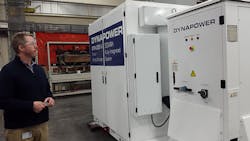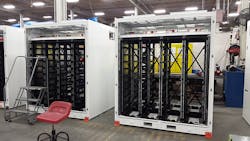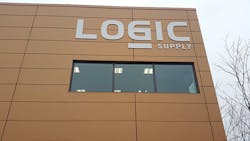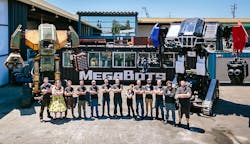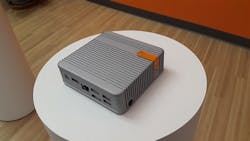In the first five parts of this series, I toured a variety of companies in Vermont:
Revision: This military-grade safety glass company is expanding into helmets and batteries, and is proud to be a successful Vermont company.
BioTek: A company that’s disrupting the life sciences by offering high-tech testing equipment at a fraction of the cost of the competitors.
Liquid Measurement System: Making a fuel probe out of a carbon composite that weights about half of its metal competitor, LMS offers a full fuel-system solution.
Vermont Precision Tools: An ISO 9001:2000-certified manufacturer of precision ground tooling, this shop offer many processes such as centerless grinding, precision form grinding, CNC turning, CNC grinding, in-house, and heat treating, to name a few.
V-CET: Vermont’s Center for Emerging Technologies introduced us to a handful of startups that are changing the way we look at education, probe and measure, and can extend research being done in space.
Thanks to these companies, along with establishments such as Citizen Cider, 14th Star Brewery, and Zero Gravity, the tour already had me biased toward Vermont, but I soldiered on. In this part of the series, I head to Dynapower Corp. to check out energy-storage systems, inverters, rectifiers, and custom transformers. And we stop by Logic Supply to talk about its innovative management strategy, and the technology behind a 15-ft.-tall, 12,000-lb. fighting robot from MegaBots.
Dynapower
Since 1963, Dynapower has designed and built power electronics that meet some of the most challenging power-conversion demands for Fortune 500 companies, small enterprises, research institutions, and government agencies worldwide. Dynapower designs and builds all kinds of power electronics—energy storage inverters, rectifiers, custom transformers, frequency converters—in a 150,000-square-foot, vertically integrated facility in South Burlington, Vermont.
The president of Dynapower gave me a tour of the factory where they assemble power systems. Next to him is the patent-pending BTM-250, a fully integrated, 250-kW system that’s been optimized for behind-the-meter, energy-storage applications where reliability and footprint matter. The energy-storage system also uses a Smart Energy Storage Inverter (UL 1741 SA listed) integrated with Samsung E2 batteries.
The President of Dynapower, Adam Knuden, told us about some interesting project and business partners he sees in this industry. First, the Dynapower building generates over 50% of the energy it needs. Many of Dynapower’s products are for energy storage. The challenge is to not only think long-term needs and conditions, but also the wear and cost associated with this over time.
Many of these systems are large, and might take years to build. This means an estimate done with today’s cost, inflation, etc., could cause major problems when trying to finish and start up a company. Some of these systems are responsible not only for societies to keep the lights on, but it also keeps power to the U.S.’s Patriot missiles and other important infrastructures.
In addition, a designer must think about the load of a system in the future. Batteries degrade over time, so considering the heat, impedance, ambient temperature, and cycle loading, the designer needs to accurately calculate the degradation over the years. Considering these are rarely small projects, and cost, demand, and performance need to be figured out for today and five, ten, twenty years in the future, it’s a good thing Dynapower has the experience they do.
One interesting point is that the company doesn’t make batteries. This means some of the companies it cooperates with are also it competitors. This growing competition is seen more and more these days, while projects are increasingly becoming larger or more complex. Vermont government is probably excited to have Dynatech as a local company, not only for their business, but for Vermont’s passion for a “green” future.
This cabinet has slots that look like you’d slide your lunch tray into after you’re done eating. The slots are actually for inserting a Samsung battery.
Vermont’s state government published its 2016 Vermont Comprehensive Energy Plan that stated, “Five years ago, under the leadership of Governor Peter Shumlin, we embarked on a new energy future for Vermont. The goal of achieving 90% of Vermont’s total energy needs from renewable sources by 2050 was visionary, but just that—a goal.
“Since then, Vermont has shown not only the worthiness of that goal for our energy security and environmental benefit, but also its achievability and affordability … In the last five years, Vermonters have embraced this effort with enthusiasm, expanding our in-state renewables by over 250 megawatts (MW) of electric capacity. We’ve improved on our already nationally recognized work in electric efficiency, and expanded efforts to advance thermal efficiency. We added over 100 MW of new wind generation, and repowered hydropower at several existing Vermont dams in an environmentally sound manner. By far, the greatest growth has been in solar—with net metering at homes, farms, businesses, and throughout communities accounting for nearly 90 MW alone. All this while keeping the cost of electricity at or below the rate of inflation and securing electric bill reductions in three of the last four years for a vast majority of Vermonters.”
I’m sure Dynapower is ready and able to make sure Vermont’s goal is met. On Tau Island, Samoa, Dynapower with other companies, including Tesla and Solar City, have reduced the use of diesel by over 90%, and the island can be powered for three days without sun.
Logic Supply
Logic Supply was launched in 2003 after the introduction of the Mini-ITX form factor. The small, energy-efficient platform was ideal for applications that previously depended on expensive, custom embedded products. Logic Supply was the first online Mini-ITX distributor in the U.S. and a pioneer in applying this platform in the industrial and embedded computing market.
While Mini-ITX remains core to what Logic Supply does, it has expanded into other form factors while continuing to focus on what made Mini-ITX attractive—small, low power, rapidly customizable, cost-efficient, and readily available.
Over the years, customers have put these computers in hospitals, helicopters, taxi cabs, mines, cranes, dump trucks, meat-processing facilities, grocery stores, and traffic-control centers, as well as in manufacturing and heavy industrial environments requiring the most rugged of systems. In addition, this is some of the technology behind a 15-ft.-tall, 12,000-lb. fighting robot from MegaBots. And, oddly, that’s not the most interesting part of this innovative company.
A fighting robot sounds exciting, but before you forget finishing this article and click on the MegaBots link to watch the episodes, remember, Logic Supply is responsible for some of the driving technology in the robots.
While it’s hard to upstage fighting robots, Logic Supply’s employees are not involved with them directly. As an employee, the interesting part of this company is communication and transparency. Once employed by Logic Supply, you get access to speak to anyone up to and including the CEO; have your voice heard at the monthly company meeting; and check out a share page where you can see what everyone is getting paid.
During our tour, they said that latter point has never been a problem. People might think this is uncomfortable, but Logic Supply wants to have these uncomfortable conversations. One time, an employee brought up that it wasn’t fair when a new engineer came in and started with a higher rate than them. The managers sat down with the individual and talked it out. It turns out the employee was unaware of the experience the new engineer brought to the table, and some of the responsibilities assigned to the new person.
This is just one small way to show that Logic Supply is paying attention to the end user. The CL100, which is compact (4.5 × 4.5 × 1.5 in.) and has a 4K media playback, is perfect for storing behind a wall-mounted monitor for a sleek look. However, the powerful processor had the power button on its face, which meant to mount it vertically and sandwich it between a wall and monitor would make it unreachable. This wraparound button lets the user hit the power button no matter how it is mounted. It operates quietly without a fan and is able to run multiple independent displays in a lightweight, ruggedized aluminum chassis that’s well-suited for digital signage and industrial workstations.
By keeping things open and having those, sometimes, uncomfortable conversations, management learns more about what they need to do to keep their employees happy. If someone complains about a pay difference, they might discover someone is underpaid.
Perhaps someone sees the pay scale and feels they aren’t getting enough money. Management can show the responsibilities of that position and how they associate with that pay. If the employee thinks he or she could take on those responsibilities to get a pay raise, management now knows this and can adjust. It eliminates any question to equal pay in the workplace—if you literally see a pay issue on that share page, you can talk to a manager about it the day you’re hired. So far, Logic Supply is still going strong.
These are just some samples of the technology and state benefits that come from working in Vermont. As these companies grow, the state—like most of the world—will be in need of talented people. So, if you like small, scrappy, blue-collar companies that promote transparency and organic growth, and believe in a work-life balance, check out Vermont. The state has much more to offer than snowboarding and maple syrup, although both are good to have, too.

